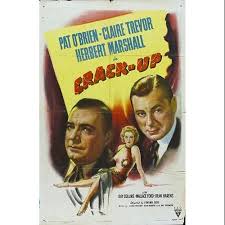
CRACK UP
US, 1946, 93 minutes, Black and white.
Pat O' Brien, Claire Trevor, Herbert Marshall, Ray Collins, Wallace Ford, Mary Ware.
Directed by Irving Reis.
Crack-up is quite an interesting drama of 1946, capitalising on the atmosphere of post-World War II, and the development of the dark thrillers, the film noir.
Pat O’ Brien, generally seen in genial roles in the Warner Brothers films of the 1930s, including a number of priests, is a strange choice for the art expert, though it is explained that during World War II he was verifying the authenticity of paintings taken by the Nazis (which links it to the 2014 George Clooney drama about war art, The Monuments Men). Here he is giving a series of lectures, with a touch of cynicism about what people like and modern art. However, he is taken drunk at the Art Gallery and has a story about being on a train which crashed – something of the title.
But there is a complication with a Scotland Yard Inspector, Herbert Marshall, visiting the US to investigate the destruction of a painting by Gainsborough and the possibility of art forgeries and stealth. His not sure of Pat O’ Brien’s involvement and enlists the help of his girlfriend, played by Claire Trevor.
There are further forgeries, further murders, and a revelation that an avaricious doctor on the board of the Art Gallery has been stealing the paintings and commissioning forgeries – and also using psychological drugs to induce the impression of a train crash. There is a last-minute explanation of all that has been going on and further last-minute coming in by the police and the Scotland Yard detective to save Pat O’ Brien and Claire Trevor. Still quite an interesting film.
1. Drama, film noir, 1946? The postwar feel? Art world? Police and detection? Psychological developments?
2. Black-and-white photography, the atmosphere, the art gallery, apartments, the police, the train and the crash, socials? The musical score?
3. The title, George and his war experiences, his mental state? Open to suggestion, imagining the train crash?
4. The art world, George, his lecture series, his comments on modern art, his audiences, the flip touch, the reaction of the authorities, of the board, wanting to stop the series?
5. The structure of the film: George, the gallery, the flashbacks, the train crash, the forgeries, his investigation?
6. George, Terry, and the relationship? The tension? Traybin and his presence, Herbert Marshall’s presence and style, British, serious, gravitas? George’s puzzle? The drink, the crash, the interrogation by Cochrane, his recounting of his travel, buying the ticket after the phone call, in the train, re-living the crash? His getting out, wandering? Cochrane and his suspicions? Cochrane being influenced by Traybin?
7. George, the lecture, the response, the drink with Terry, the phone call, facing the fact that there was no train crash? His breakdown?
8. The contact with Stevenson, friendship, the discussions, meeting, finding Stevenson dead? Seeing the director of the gallery and later confronting him?
9. The story of the Gainsborough painting, destroyed in the ship, Traybin and Scotland Yard, his working with Cochrane, with Terry, trying to gauge whether George was involved with the forgery and the destruction?
10. The socials, the role of Reynolds, Traybin at the party, his offering to help George?
11. George, retracing his steps, asking people if they recognised him, going on the train, getting off, the information about the train? The theory, of a house somewhere near the rail line, going to the director and confronting him?
12. Mary, her role at the gallery, friendship with Dr Lowell, getting her friend to help, George and his going to the ship, getting assistance, getting off the ship with the painting, evading the police, the copy, the wherewithal to check whether the paintings were fakes? Mary, the phone call to Dr Lowell, the taking of Terry and George?
13. Lowell, on the board, sinister, the revelation of the truth, taunting Terry, George unconscious, the explanation about the train, the drugs, hypnotic? The sounds of the train going past the house? Mary and her aggression, with the gun? Lowell and his aesthetic greed?
14. Traybin, the entry, the shootings, and the explanations?